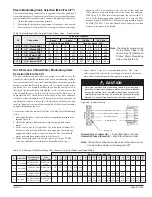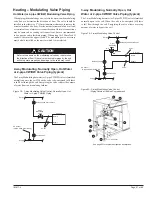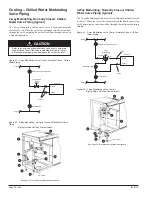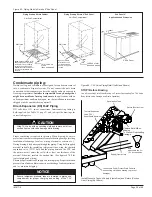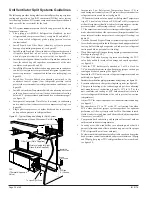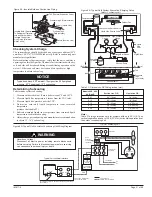
Page 16 of 60
IM 817-4
Make Piping Connections
Be sure the hot and chilled water supply and return system are
thoroughly flushed and cleaned before connecting piping to the
unit ventilator. Debris in the lines can damage the unit.
For All Systems
Be sure to install the control valve(s) on the correct unit ventilator.
Indiscriminate mixing of valves in the field can result in valves
improperly sized for the desired flow rate, which can result in poor
operation and coil freezeups. Install control valve so there is at least 2"
(51mm) minimum clearance to remove the actuator from the valve body.
Be certain that the control valve is installed correctly, with its orientation
vertical. Valves should be installed at least 5º off center.
Be certain that the control valves are installed with the proper
port orientation to provide proper flow and fail safe operation.
Incorrect installation can result in improper unit operation, and/or
the possibility of coil freeze-up.
With future servicing considerations in mind, use standard, field-supplied
shutoff valves and union connections; this permits easy removal of the
coil or control valve if servicing is required.
While brazing, have an extinguisher readily available. Wear
appropriate eye and hand protection. Ensure all areas with
shared ventilation have ample fresh air ventilation.
Proper ventilation is required for brazing. When brazing, be sure to
protect unit ventilator components from overheating damage (melting
insulation, also damage to valves, wiring, electronics, sensors, etc.).
Before filling, be sure to flush all piping adequately so that all debris
is removed. Debris can prevent proper valve operation, resulting in
overheating, overcooling, etc.
Ensure proper insulation of supply and return piping. Proper insulation
prevents loss of unit ventilator capacity, overheating of end compartment,
and / or moisture dripping.
The piping to and from the unit must be protected from outside air and
freeze conditions. The piping must be suitably insulated for condensation
or heat lose or gain. Penetrations entering the unit end compartments
must be fitted/sealed for unit integrity.
Refer to figure 32 and figures 26 and 27 and attach the unit ventilator
to the wall through the four (4) mounting holes provided, using field-
supplied fasteners appropriate to the wall construction and the washers
provided in the brown envelope with these instructions (figure 37).
Envelope also contains allen wrench to provide access to unit. Push
the unit ventilator tight to the wall structure so that the outdoor air seals
are compressed. Secure the wall fasteners to prevent the unit ventilator
from moving and tipping over.
Remove
moldings
behind unit
Unit must be anchored to an internal wall column or other suitable
support (see figure 32, page 14)
Figure 36 - Setting The Unit Ventilator In Place
Figure 35 - Leveling Legs Location
Figure 37 - Shipping Envelope Contents.
Unit Ventilator Installation
Before setting the unit ventilator in position, be sure that field-supplied
electrical connections are in place, de-energized and in accordance
with the plans.
Move the unit ventilator into position against the wall surface. Check
to see that the unit ventilator is level from end to end and back to front.
Using a 4' level is recommended. Leveling bolts are located at each
end of the front kickplate (see figure 35).
CAUTION
CAUTION
WARNING
CAUTION
Face and Bypass damper set-up is required at start-up.
Failure to properly set-up Face and Bypass damper can result in
control problems and unit damage not covered by warranty.
Refer to Service Bulletin, UV-SB-106507312.
NOTICE






















